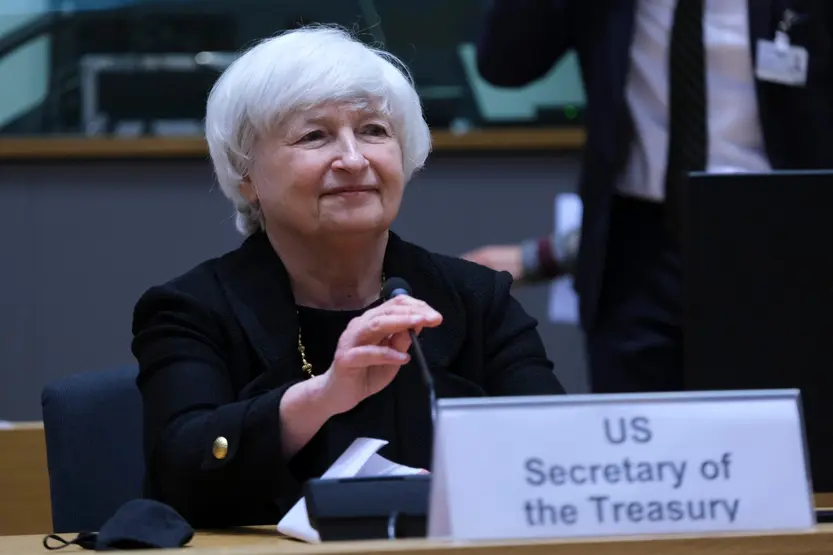As the stablecoin’s size grows, Tether’s reserves are under scrutiny from the authorities

Contents
Global authorities are becoming increasingly concerned over the fast-growing tether stablecoin, also known as USDT. The crypto has attracted attention over how it’s backed, who is doing the backing and whether it is sustainable.
Before we get into the details, though, we should explain what USDT is and what it is supposed to do.
What is tether (USDT)
USDT is what is called a stablecoin. This means it is designed to be pegged to the dollar, so it constantly maintains a value of $1. Every unit that is in existence is fully backed by traditional currency that is held in reserve.
Do not let this stability fool you into thinking that the coin is dull, though. So far this year, we have seen the number of people investing in the coin, and the overall market cap of the tether cryptocurrency, explode.
The size of the tether stablecoin has more than trebled during 2021, surging from $21bn on 1 January to nearly $69bn on 6 October. The stablecoin has almost consistently managed to rank as the world’s third-largest cryptocurrency, although, at the time of writing, it is fourth, behind bitcoin, ether and cardano. It is also the undisputed market leader when it comes to stablecoin and is streets ahead of rivals such as USD coin, gemini dollar and DAI.
Now we have answered the question "what is USDT?", we will tell you about how it works.
How USDT works
So, USDT is the biggest stablecoin there is. What makes it somewhat controversial is how it is backed. People take their money and give it to Tether Holdings, which gives them USDT in return. If the trader is working with the United States dollar, it should, in theory at least, be a straight swap of fiat dollars to crypto USDT. As for the company behind the coin, it holds on to the money it is sent in case someone wants to swap their stablecoin back for fiat. At least, that is what it is supposed to do.
The problem arises because there is no real consensus as to who backs USDT. This was not necessarily a problem in the eyes of crypto traders, though. As long as they were able to swap their fiat for the stablecoin, it did not matter. Often, the stablecoin was used to facilitate other crypto deals, so the matter of exchanging it back to fiat currency was something of a moot point.
What changed things was the crypto boom of early 2021. As more and more cryptocurrencies became more and more valuable, and there was an ever-increasing number of people dealing with crypto, stablecoins became less of a curiosity and more of a useful tool. Tether got in on the action and, out of the $68.71bn USDT currently in circulation, $48bn was minted this year.
Because the cryptocurrency is tied to the value of the dollar, that should mean that, somewhere, there is $68.71bn that exists purely to back the cryptocurrency. The problem is, no one is entirely sure whether this money exists and, if so, where it is and who is looking after it. Does tether have reserves? Yes. How much reserves does tether have? Well, it says there is $68.71bn backing it up, but this has been the subject of some controversy.
USDT/USD price history
| Date | Close | Change | Chg% | Open | Min. | Max. |
|---|---|---|---|---|---|---|
| 2022-09-30 | 0.9994000000000001 | -0.0001 | -0.01 | 0.9995 | 0.9994000000000001 | 0.9996 |
| 2022-09-30 | 0.9995 | 0.0002 | 0.02 | 0.9993000000000001 | 0.9991000000000001 | 0.9995 |
| 2022-09-30 | 0.9993000000000001 | 0.0001 | 0.01 | 0.9992000000000001 | 0.999 | 0.9993000000000001 |
| 2022-09-30 | 0.9992000000000001 | 0.0005 | 0.05 | 0.9987 | 0.9982000000000001 | 0.9993000000000001 |
| 2022-09-30 | 0.9987 | -0.0001 | -0.01 | 0.9988 | 0.9983000000000001 | 0.999 |
| 2022-09-30 | 0.9988 | -0.0005 | -0.05 | 0.9993000000000001 | 0.998 | 0.9994000000000001 |
| 2022-09-30 | 0.9993000000000001 | 0.0006 | 0.06 | 0.9987 | 0.9985 | 0.9995 |
| 2022-09-30 | 0.9987 | -0.0004 | -0.04 | 0.9991000000000001 | 0.9981000000000001 | 0.9995 |
| 2022-09-30 | 0.9991000000000001 | -0.0001 | -0.01 | 0.9992000000000001 | 0.9971000000000001 | 0.9993000000000001 |
| 2022-09-30 | 0.9992000000000001 | 0.0002 | 0.02 | 0.999 | 0.9988 | 0.9993000000000001 |
| 2022-09-30 | 0.999 | -0.0002 | -0.02 | 0.9992000000000001 | 0.9989 | 0.9996 |
| 2022-09-30 | 0.9992000000000001 | -0.0005 | -0.05 | 0.9997 | 0.9991000000000001 | 0.9997 |
| 2022-09-30 | 0.9997 | 0.0003 | 0.03 | 0.9994000000000001 | 0.9993000000000001 | 0.9998 |
| 2022-09-30 | 0.9994000000000001 | -0.0001 | -0.01 | 0.9995 | 0.9992000000000001 | 0.9998 |
| 2022-09-30 | 0.9995 | -0.0001 | -0.01 | 0.9996 | 0.9993000000000001 | 0.9999 |
| 2022-09-30 | 0.9996 | 0.0001 | 0.01 | 0.9995 | 0.9994000000000001 | 0.9998 |
| 2022-09-30 | 0.9995 | 0.0000 | 0.00 | 0.9995 | 0.999 | 0.9997 |
| 2022-09-30 | 0.9995 | 0.0002 | 0.02 | 0.9993000000000001 | 0.9903000000000001 | 0.9999 |
| 2022-09-30 | 0.9993000000000001 | -0.0004 | -0.04 | 0.9997 | 0.9993000000000001 | 0.9999 |
| 2022-09-30 | 0.9997 | 0.0000 | 0.00 | 0.9997 | 0.9994000000000001 | 0.9999 |
Tether reserves
$69bn is a lot of money. Theoretically, it should be somewhere, but no one knows exactly where. An investigation by Bloomberg drew a blank, although the financial news site was able to speak to the chairman of a bank that did business with Tether.
Jean Chalopin, of Bahamas-based Deltec Bank and Trust, defended Tether, saying: “There’s no agenda or plot. They are not Enron or Madoff. When there’s a problem, they fix it honourably.”
Chalopin, who first found fame as one of the creators of the 1980s cartoon Inspector Gadget, said the money behind USDT was real when his bank started doing business with the stablecoin in 2018, adding: “Frankly, the biggest thing was at the time, ‘the money doesn’t exist’. We knew the money exists! It was sitting here.”
However, Chalopin said that around $15bn of the tether reserves was with Deltec at the present time, adding: “I cannot speak about what I cannot know. I can only control what’s with us.”
Bloomberg also found that Tether had invested in a number of Chinese companies. The news service said: “If [Tether CFO Giancarlo] Devasini is taking enough risk to earn even a 1% return on Tether’s entire reserves, that would give him and his partners a $690m annual profit. But if those loans fail, even a small percentage of them, one tether would become worth less than $1. Any investors holding tethers would then have an incentive to redeem them; if others did it first, the money could dry up. The bank run would be on.”
The article also quoted Devasini’s lawyer, Stuart Hoegner, as saying: “We maintain a clear, comprehensive and sophisticated risk management framework for safeguarding and investing the reserves.”

Pressure builds
Earlier this year, the Financial Times quoted Monsur Hussain and Alastair Sewell of the ratings agency Fitch as saying that “potential asset contagion risks linked to the liquidation of stablecoin reserve holdings could increase pressure for tighter regulation of the nascent sector”. It also reported the president of the Boston Federal Reserve, Eric Rosengren, as saying stablecoins could easily trigger a financial crisis unless more regulation was in place.
In the United States, the President's Working Group on Financial Markets (PWG), chaired by the US Secretary of the Treasury, Janet Yellen, met earlier this summer to discuss issues concerning Tether and other stablecoins.
In a statement, the working group said: “In the meeting, participants discussed the rapid growth of stablecoins, potential uses of stablecoins as a means of payment, and potential risks to end-users, the financial system and national security. The Secretary underscored the need to act quickly to ensure there is an appropriate US regulatory framework in place.
“The group also heard a presentation from Treasury staff on the preparation of a report on stablecoins, which would discuss their potential benefits and risks, the current US regulatory framework, and the development of recommendations for addressing any regulatory gaps. The PWG expects to issue recommendations in the coming months.”
The working group has still not issued its recommendations about stablecoins. However, at the end of last year, a group of US Members of Congress called for stablecoins to be subject to banking charters before being allowed to trade. In a statement, group member Rashida Tlaib said: “From the OCC to the Federal Reserve to those peddling stablecoins, the protections the STABLE Act would make possible are more needed than ever amid a pandemic that will breed riskier financial decisions out of necessity because our federal government continues to fail us all by not providing adequate relief legislation.”
Perhaps more notably, the US Department of Justice was reported earlier this year to be holding an investigation into Tether.
Bloomberg wrote that the DoJ was looking into whether Tether executives committed bank fraud during the early years of the coin's life. It reported that three people with knowledge of the matter had said the investigation centred on whether Tether had concealed from banks that transactions were linked to crypto.
We asked the Department of Justice if it was able to comment on the report, but have not received a response as yet.
A spokesman for Tether said at the time:
“Tether routinely has open dialogue with law enforcement agencies, including the DoJ, as part of our commitment to cooperation and transparency.”
We also asked Tether to comment on the coin’s reserves and whether it had a response to the working group, but have not yet received a reply.
FAQs
There are $68.71bn tether stablecoin in circulation as of 12 October 2021.
It is hard to say if USDT is a good investment or not. The point of the crypto is to stay at around $1, while offering people a stablecoin to trade with. There are also some concerns over what is backing the coin. That's not to say you should not invest in it, just be cautious.
If you want to buy USDT, you can do so at dzengi.com. Just remember to do your own research and never invest more than you can afford to lose.

